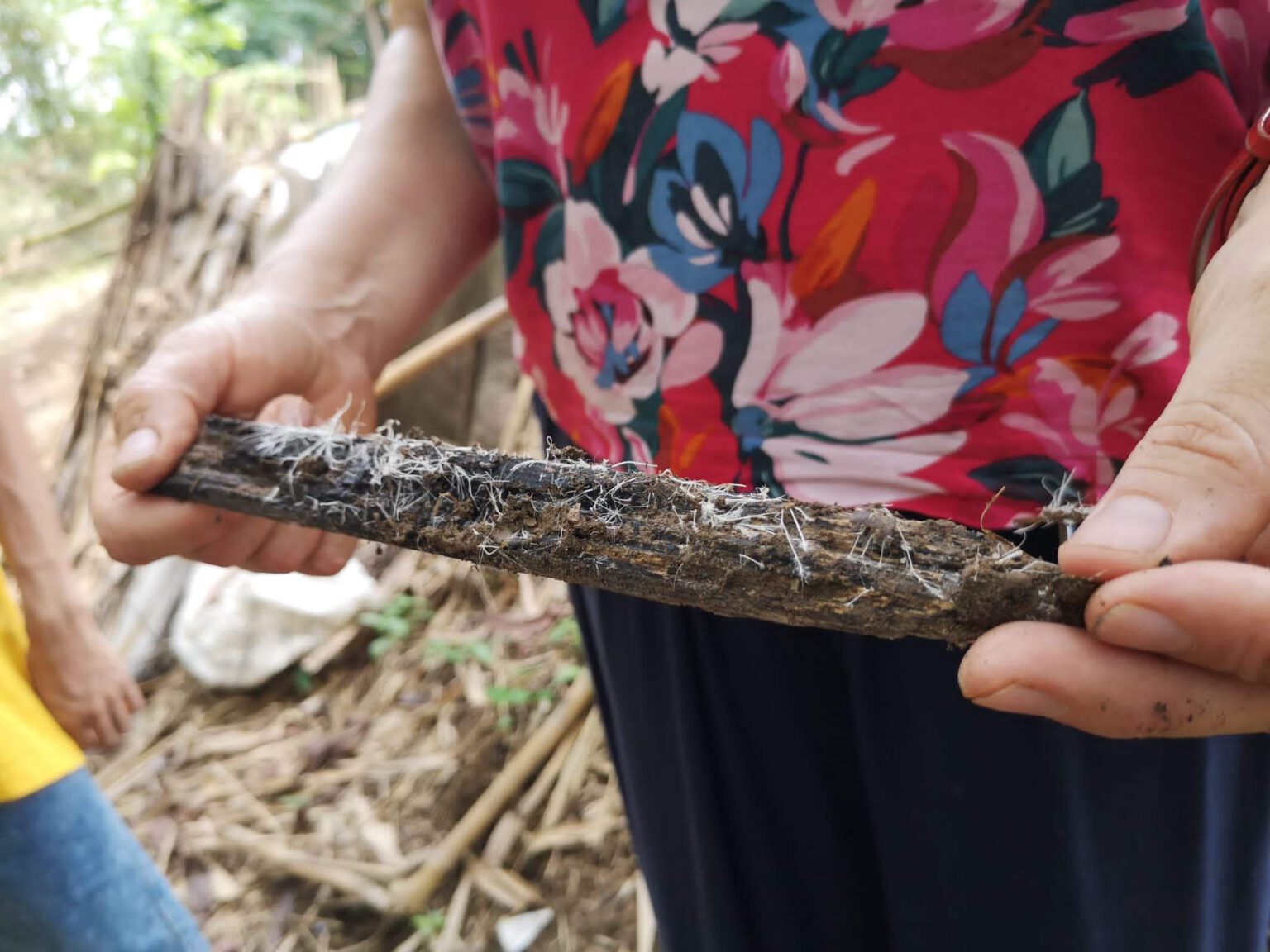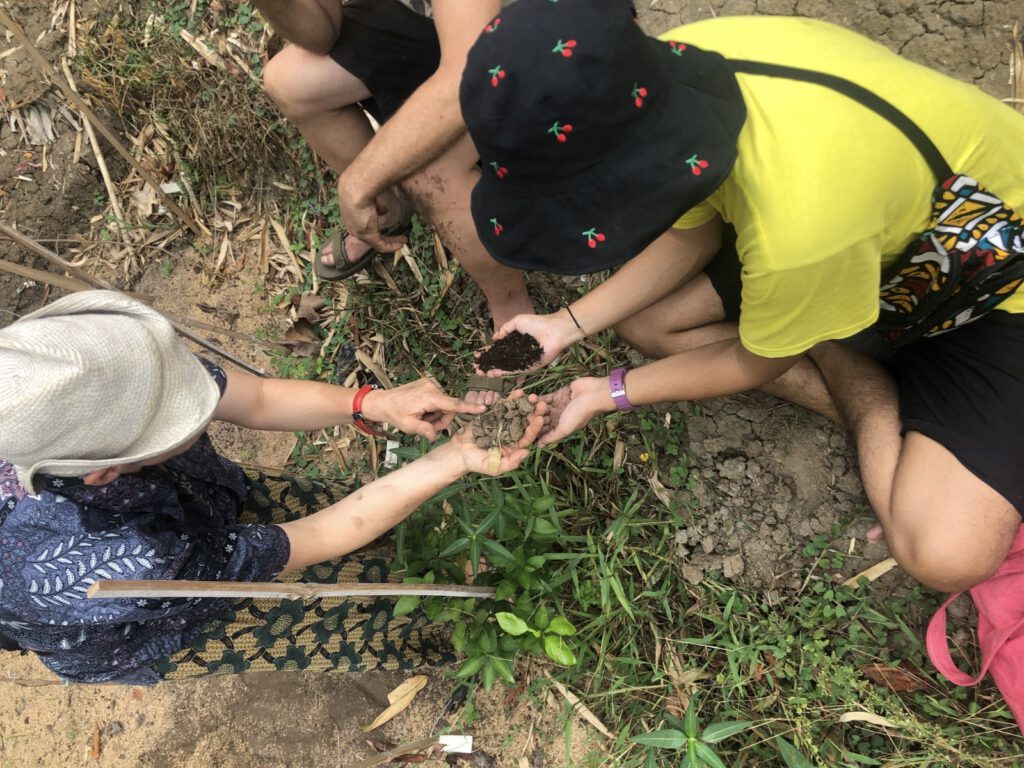Touching the soil or how we can re-connect with microbial ancestors
EVENT // WORKSHOP BY ELLA VON DER HAIDE// 08. DECEMBER 2023 JATIWANGI // JATIWANGI ART FACTORY // WRITTEN BY ELLA VON DER HAIDE
On the last day of our tree weeks artist/gardener-residency stay at Jatiwangi art Factory I (Ella von der Haide) invited four Perhutana stewards from Jatiwangi. At different places in the future Perhutana area we dug the earth and touched, smelled and looked at the soil and at the plants that are already growing there. Our aim was to understand the role of living soil for the growth of plants in general and especially the trees that will be planted here in the years to come. We met the local –microbes, fungi, worms etc. We tried to find out where they are already thriving or and where not so much and why. We wanted to understand what could be done to invite microbes back to depleted soil, to start creating more humus and soil aggregates, so that the trees in the future Perhutana project would grow and survive the always longer dry seasons.

During our walk we found, that the soil in some of the rice fields, was very compacted and hard, so that no air could infiltrate. The ground in these areas would have to be worked with machines and tools and fertiliser would have to be added to be able to grow something, since without air no microbes are living in the soil and nutrients are rarely available.
We saw that in fallow corners of the field some repairing /healing weeds had already stared to grow. “Nature” was trying to cover the barren earth to keep the nutrients from being washed out and creating shade for the UV-rays-sensitive microbes.
And we where glad to see, that on the edges of the field, close to the rivers, under the bamboo there are already, even after a very hot and long dry season of 2023, some patches where white fungi are busy composting and braking down fallen bamboo leaves and branches to make humus. The soil there was moist and had a crumbly structure; it was a perfect example to experience by touching the humid soil that microbes create soil aggregates out of the tight packed clay particles, which are so important for making waterproof roof tiles. These soil aggregates, also called clay-humus-complexes are like little sponges that hold big amounts of water, and prevent flooding and dry out much later, they are creating a moist but ventilated microclimate, they fixated nutrients even in heavy tropical rainstorms, they sequester CO2 out of the air and allow the roots of plants to grow and find just the right amount of minerals and at the same time these aggregates are the perfect habitat for more microbes.


It always fills me with awe, how these invisible, very old beings create an environment that is good for them and are caring at the same time for us, creating a good habitat for us humans as well as all other beings.
Finding out about all diverse processes that already existed in the Perhutana fields led us to several ideas how the Perhutana stewards could care for the soil microbiome. As a first step the stewards dedicated a parcel of the field to be set aside and leave it fallow. The idea is to find out what “nature” will do, to repair the soil and bring back live. It is an experiment to get to know the local vegetation. From such an example lots can be learned about what seeds are still in the ground, what kind of vegetation likes the microclimate in that location and in what order trees would re-establish themselves. It is also a good lesson to learn that human actions are not always needed and that there is a lot of wisdom in the natural processes that we can learn from.
One other suggestion was to collect biomass from the surrounding areas and the village. The people in Jatiwangi could be invited, to bring organic matter from kitchen straps to tree clippings to feed the microbes in the ground.
Another idea was to plant more bamboo on the edges.
One suggestion was to widen the raised paths across the fields and plant them with a variety of edible plants all year around, so that microbes would have areas they could retreat to in the dry seasons and people would have something to look at when wandering over the field.
We ended our walk by planting the seeds from Tunas Nusa Foundation.
After these hours of attentive listening to the soil in the Perhutana fields I’m feeling very much connected to this land. I’m sending all my best thoughts and wishes from Germany where I am involved in similar projects of repairing land after a long history of industrial agricultural use. May the sacred forest grow and the symbiotic relationships with the soil microbes thrive.
I continue working with microbes and fungi here in Germany… see my work shops and performances.
Best Greetings, Ella
